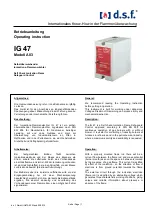
KTR-STOP
®
S-A-F B-xx
Operating/Assembly instructions
KTR-N
Sheet:
Edition:
44591 EN
16 of 24
5
Please observe protection
note ISO 16016.
Drawn:
2019-08-13 Pz/Mro
Replacing:
KTR-N dated 2018-12-04
Verified:
2019-08-13 Pz
Replaced by:
Before start-up and after each operation on the brake the hydraulic system has to be gener-
ally vented.
Repeat venting the brake several times a year, since any air in the hydraulic system may
affect the operation of the brake and the plant.
!
Make sure that there is sufficient liquid in the hydraulic system during and after the venting
process (recommendation of liquid, see chapter 4.10).
•
Put some pressure on the hydraulic system. This will allow the brake pads to fit onto the brake disk.
•
Applying with the use of a sensor only:
Mount the sensor (component 9) according to chapter 6.2 instead of the screw plug (component 1.20).
•
The brake pads have to be ground in on the surface of the brake disk to achieve the nominal coefficient of
friction.
Please observe the instructions for grinding-in according to KTR-N.
!
You may only use mineral hydraulic fluids meeting the specifications of DIN 51524. KTR
recommends those fluids corresponding to DIN 51524-3.
KTR recommends the following fluids (other manufacturers may be selected):
Manufacturer
Standard
Special
Mineral oil
- 20 °C to + 40 °C
(- 4 °F to 104 °F)
+ 10 °C to + 60 °C
(+ 50 °F to + 140 °F)
- 30 °C to + 20 °C
(- 22 °F to 68 °F)
+ 30 °C to + 70 °C
(+ 86 °F to + 158 °F)
Castrol
Hyspin HVI 32
Hyspin HVI 46
-
Hyspin HVI 68
Shell
Tellus TX32
Tellus TX46
Tellus Artic
Tellus TX68
Mobil
DTE 13M
DTE 15M
-
DTE 16M
Hydro Texaco
Rando HDZ32
Rando HDZ46
Rando Ashless 8401
Rando HDZ68
Valvoline
Ultramax HVLP32
Ultramax HVLP46
-
Ultramax HVLP68
The permissible operating temperatures of brake components from - 20 °C to + 60 °C (- 4 °F
to + 140 °F) have to be observed. For deviating operating temperatures please consult with
KTR.
Viscosity
We would recommend a viscosity range from 20 to 220 mm
2
/s (cSt) of the hydraulic fluid with operating tempera-
ture. The viscosity during starting should not exceed 500 mm
2
/s and the viscosity during operation should not fall
below 12 mm
2
/s.
Filtration
When filling and re-filling the hydraulic system and replacing the hydraulic fluid, the oil needs to be filtered. For
that purpose use an offline filter or a respective fill unit. In addition we would recommend to use an inline filter.
4
Assembly
4.8 Start-up of the brake
4.9 Recommendation of fluids to be used









































